Madagascar: The Great Red Isle

Madagascar Facts
Fourth largest island in the world
Population: 19 million people
Demographics: Maylay seafarers arrived between 1,500 and 2,000 years ago, followed by East African peoples. The people today are known as the Malagasy, and recent DNA findings show they are "approximately of half Malay and half East African stock". Today 36 seperate tribal groups exist.
Language: Malagasy (a Maylayo-Polynesian language that shares 90% of its vocabulary with Maanyan language of Borneo). French is widely spoken as a second language.
Miles of coastline: 2,998
July 13
Antananarivo
 After surviving the night in Johannesburg we boarded our flight bound for the great red Isle of Madagascar. After crossing the Mozambique Channel, the coastline of Madagascar appeared in the horizon.
After surviving the night in Johannesburg we boarded our flight bound for the great red Isle of Madagascar. After crossing the Mozambique Channel, the coastline of Madagascar appeared in the horizon.Adam and I did our best to teach ourselves French prior to our arrival, but as we made our way through the Antananarivo Airport, we realized how weak our French was and that we needed to get it together quick. Yet we had the basics and were able to quickly sort out a cab. It was a little hectic as roughly 8 cabbies fought for our business and about 6 guys wanted to carry our bags.
 As we approached the capital city we observed our new surroundings. Most of the cars were Renaults and Peugeots. The main road was elevated above vast mudflats where thousands of red bricks were cut from the red clay and baked into the cities main building material. Although the city was definitely third world, I was amazed at how clean the streets were and free of rubbish.
As we approached the capital city we observed our new surroundings. Most of the cars were Renaults and Peugeots. The main road was elevated above vast mudflats where thousands of red bricks were cut from the red clay and baked into the cities main building material. Although the city was definitely third world, I was amazed at how clean the streets were and free of rubbish.After settling into our hotel we were off to take care of business; money, maps, and a plane ticket to the coastal town of Tulear. I quickly realized I was screwed because the ATMs only took cards with Visa and mine was MasterCard. Luckily Adam's was Visa, but we had to rely on his card for the rest of the trip. After finding the Air Madagascar office, we took a number, and in about 2 hours we had our ticket sorted out.
That night we enjoyed exquisite French food for pennies and the legendary nightlife of Tana. The people are incredibly beautiful, a mix of the original settlers from Malaysia/Indonesia (arriving about 2,000 years prior) and the Africans who arrived much later.
The Ampanihy Coast

Off to Tulear we approached the coastline and saw the great expanses of coral barrier reefs below and calm seas. Beyond the coast lies the great spiny forest, an arid landscape that stretches as far as the eyes can see. We arrived at a small hotel called Chez La La and jumped in a Pus Pus (a 2 wheeled rickshaw) to check out the scene. Our driver Patrique was eager to be our chauffer and tour us around the town.



Tulear hustles and bustles, Pus Puses carrying people here and there, everyone trying to sell you anything, beautiful girls trying to get your attention (what planet are we on??). And here's an overgeneralization for you, albeit true, the Malagasy are the happiest and most friendly people in the world. Everyone smiles, everyone greets you on the streets.

Tuler was our jumping point for our real adventure to the south.
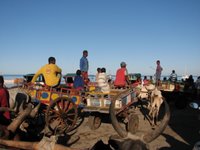 To the south the roads basically end and become dirt, most fizzling out and eventually becoming 4wd dirt tracks. Some, but not all, of the towns can be reached by Taxi brousse (bush taxi) which consist of any type of vehicle filed to its keel with people, chickens, goats......... long and grueling. The south also lacks phones, electricity, and sometimes fresh water.
To the south the roads basically end and become dirt, most fizzling out and eventually becoming 4wd dirt tracks. Some, but not all, of the towns can be reached by Taxi brousse (bush taxi) which consist of any type of vehicle filed to its keel with people, chickens, goats......... long and grueling. The south also lacks phones, electricity, and sometimes fresh water.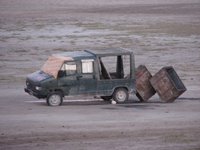

 The next day we were up early to catch a boat to our first surf destination of Anakoa. We traveled by motorboat along the inner lagoon for about ten miles, passing small isolated fishing
The next day we were up early to catch a boat to our first surf destination of Anakoa. We traveled by motorboat along the inner lagoon for about ten miles, passing small isolated fishing villages along the way we passed a large bay that was once a strategic location for pirates who would pray on unsuspecting boats returning from the far east.
villages along the way we passed a large bay that was once a strategic location for pirates who would pray on unsuspecting boats returning from the far east.
The first thing that I noticed on the beach was that the Vezo used it as a toliet. Children, and adults included, would do their thing below the high tide line. Once the tide came in, it would all be washed out to sea. The huge reef system takes care of the waste no problem, and it's actually a better system than it may sound. Just watch out for baby pudding (that's what we called it) at low tide!
 Our boat man dropped us of off the beach at Anakoa; I sat with our pile of stuff while Adam went to sort out our accommodation at Chez Emile. It turned out that Emile was the cheif of the village, and his establishment was the only one that supported the local community, versus the French and South African resorts up the beach. For $4 a night, we each had a bungalow located on the sand dunes overlooking the beach and town. To our rear lay the vast spiny forest....a no-man's land that seems to go on forever.
Our boat man dropped us of off the beach at Anakoa; I sat with our pile of stuff while Adam went to sort out our accommodation at Chez Emile. It turned out that Emile was the cheif of the village, and his establishment was the only one that supported the local community, versus the French and South African resorts up the beach. For $4 a night, we each had a bungalow located on the sand dunes overlooking the beach and town. To our rear lay the vast spiny forest....a no-man's land that seems to go on forever.In front of Chez Emile's bungalows was his family run restaurantand bar where we would drink and socialize with random travelers at night. There were many travelers from France and Italy, most the surfers coming from South Africa and Reunion.
That's where we met Maggot from Australia, a truly classic character. He appeared to be in his 50s, but he was one of those guys who looked older than he probably was. Blond shaggy hair, skin wrinked and tanned like weathered leather, bags drooping below his opal eyes. He was a salty dog indeed.
Maggot resided permanently on Reunion Island, and came to Madagascar once a year on holiday. He was one of the pioneers of west Indian Ocean surf exploration, having discovered many of Madagascar's hidden treasures. After hearing of our round-the-world oddysey, he took an instant liking to us. Each day we would team up with Maggot and his buddy Dick, surfing the surrounding reefs and islands via Vezo Laka. We scored some decent waves, but the fickle wave on the north end of Nosy Vey never showed herself.




A five minute walk into the spiny forest
revealed some Malagasy tombs. The more
important you are, the bigger your tomb,
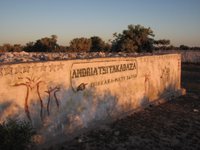
and the more bulls you are buried with.
Count the horns kids!

The Vezo Laka, paddle or sail, no petrol required.
In the background lies Nosy Vey Island, home to
the premier wave in Madagascar.

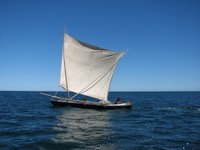
Boat building is an art the Vezo men
begin practicing at about 3 years of
age. Kids start off by making toy boats
(that actually sail!) and move up from there.


Madam Coco and Adam

One of Madam Coco's lobster diners.
We paid $3, she would shuttle the same
meal to the South African surf camp for $10.


Madam Coco Family, with our
good friend Matyas from Reunion.


A sample of what lurks below.

After spending about a week in Anakoa with little surf and lots of South Africans, we knew it was time to head south. We sat down with Maggot that night and decided that we would loosen him up with a few drinks. After three Caparinis, made nice and stiff with the local rum, we shared our knowledge of the south coast with Maggot and our plans. Maggot was quite pleased with us and was happy we were continuing the tradition of true surf exploration (versus the all-inclusive surf resort/boat charter pakage deal of today). He confirmed a lot of what we had already found out from the local fishermen, but he knew that if he named names and drew maps for us he would be taking away the real experience of finding and discovering new waves for ourselves. Maggot slurred like a drunken salty-dog, "We old blokes gladly pass the torch on to you youngins...tops to both of ya mate...." and then he stumbled away into the darkness.
The Adventure South

With the predominate wind blowing from the south and the distance we wanted to travel, going by sailing pirogue (Laka) was out of the question. We negotiated a motorized boat with some guys who were family of chief Emile. We were able to work out a deal, and the next day we were off. It took us about three hours to travel the 20 miles of coastline, passing small villages and countless pirogues along the way. Diving, fishing, and harvesting the oceans bounty.....the sea was truly the Vezo's provider in this remote and desolate stretch of coast.


Upon reaching our destination of Andavaposa, we had the choice of staying in some bungalows with a Malagasy man or a small beach front hotel outside of town, owned by an Italian catering to wealth Euro tourists. We decided to stay with the people.

"Chez Gene" was made up of two small thatch roofed bungalows on the beach, one for Adam and one for me. Gene was from the Plateau and the city of Antananarivo. He was tired of the city life and had come here to carve out his own little empire out of the spiny forest coast. He lived there with his wife and three kids in a simple existence....no cars, phones or hassles of the city.

About a two minute walk up the beach was the small village of Antanandava, made up of about 100 people and perhaps 20 Lakas (sailing canoes). The homes of the Vezo are simple dwellings, walls made from small branches with thatched roofs and sand floors. There is one small cement building which serves as the corner store. Basic goods like warm Three Horse Beer, "Sambo" Rum, and rice.

In front of our bungalows was a small reef pass that was rumored to be a good quality wave. It was flat, but we were not surprised. We were used to waking up to small Waves. The next day was even smaller. It went from Santa Cruz in the summertime, to the lake-like Florida. Moral was low and it was time to get some rum.

As we walked into town we gave our greeting of "Salama" to everyone we saw. "Inan vovo?" (What’s news) we would ask. "Chimish" (no news), they would reply with a smile. It was quite apparent to us that few Vazaha (white) people strolled through their town. We met two brothers, Sampson and Marco, who were sitting around a fire with about 8 kids. These men were built like rocks, every muscle of their bodies fully developed from being Vezo fishermen. We tried to explain to them our purpose for being in their town in our best French and Malagasy. We quickly realized that almost no one spoke French.
They directed us to the store and a couple of the children guided us down narrow little "alleys" lined with stick fences, passing piles of fish scales in the sand, seeing fish and squid drying in the sand. We came to the small store and were greeted by a stunningly beautiful woman. In her early 20s, she stood with her baby wrapped on her back (I swear I never heard a baby cry in the Vezo Villages). She wore the traditional orangish mud mask that the women use to protect their face from the sun and soften the skin. We bought two small bottles of rum and headed back to join Sampson and Marco back at the fire.
Around the fire were rows of fish on wooden skewers, stuck vertically into the sand. More children ran out of their huts to join us. They were very curios about the Vazaha, laughing and asking us questions that we didn't understand. We broke open the rum and passed it amongst the men. Soon Sampson came out with a small bowl of fish for Adam and me. Marco and Sampson sat proud, the providers for most or all of these children. Suddenly the kids screamed with excitement and ran to a hut in the darkness. They came back with bowls of rice and big smiles on their faces. Marco gave each of the kids a small fish and they dined merrily.
The Flat Spell Breaks

The next morning I opened the door of my hut and saw that a swell had arrived overnight. Adam and I studied the wave over petit dejane' (breakfast of coffee and doughnut like bread).
The wave broke over a passage in the barrier reef creating a dredging lefthander that broke towards the deepwater channel. The local Vezo fishermen used this same reef pass to reach the outer waters. The wave looked challenging with a strange mutated bowl shutting down the last section. We had heard that the wave needed a high tide and I could see that the tide was already on its way out. It was time to give it a go.

After paddling for ten minutes across the lagoon I reached the pass where several Vezo were making their way out to fish for the day. They looked at me as if I were the oddest thing that they had ever seen. The waves began to increase in size as I sat in the deepwater channel and sussed out the wave. It became apparent that the only way to surf it was to take off deep and pull out of the wave before the final death section shut down on the coral reef. "Where the hell is Adam?" I thought to myself. We were as far as you can get from a hospital.
It turned out Adam was on the beach getting some video footage. I Paddled for my first wave, driving as fast as I could down the line, I was able to get two snaps in before I approached the inside bowl section. I pulled in under the lip of the wave, but my line was too low and I got clipped in the head. Spinning under water I gripped myself in preparation for hitting the reef, but instead I came up unscathed. I paddled over the reef with about six inches of water underneath and made it to the channel to see several Vezo fishermen hanging out in the channel watching the action.
My next wave was the best of my trip to Madagascar.....I took of on the outside and maneuvered my way down the playful wall that allowed me the freedom of turning before it reached the inside bowl. As I drove my bottom turn I could see that the wave was going square....I did a backside snap under the lip to stall and put myself into position. Standing up vertically, knees slightly bent, I dragged my rear hand across the face of the wave as the lip rotated over my head....looking out the opening I could see a Vezo fisherman, perfectly framed, watching me glide through the belly of the beast he has been taught to fear.
Later that evening we strolled into town for a warm Three Horse Beer. We were waved over by an old man sorting out his fishing net on the beach. He told us that we were the first to surf the "savage" wave across the reef pass. He told us that we should instead surf the mushy right-hander that the Italian and French surfer from Reunion had surfed before. We laughed and tried to explain to him, the best we could, that we were looking to surf savage waves such as his reef pass. I had a hard time believing that we were the first to surf the pass, but later that night Marco and Sampson confirmed that we were indeed the first. Well I guess this means we get to name it. Should we name it "Pink Pirogues" for the pink Laka on the beach in front of the Italian's Hotel?? Naa, we will name it "Spineys" after the spiny cactus that lines the beach and the spiny urchins that cover the reef. Actually we decided not to give it a name at all, it is what it is.
The Spiny Forest

 The next day we awoke to small surf and the frustration of not being able to surf much returned. We decided to take a trip to a national park located about 15 miles inland. There we entered the heart of the spiny forest, a place where every single species of plant is covered with some sort of spine or thorn.
The next day we awoke to small surf and the frustration of not being able to surf much returned. We decided to take a trip to a national park located about 15 miles inland. There we entered the heart of the spiny forest, a place where every single species of plant is covered with some sort of spine or thorn.
The ground was covered with flat slabs of limestone, which felt and sounded like loose manhole covers as we maneuvered our way up the hillside.

Soon we reached the mouth of a cave system. Inside was a fresh water lake that was home to an eyeless fish. The cave is also a sacred place to the local Malagasy, who believe that the cave is home to a race of small people who enter the forest world during the night.

 Next we found a sinkhole cave that was surrounded by Banyan trees. The roots of the Banyans had crawled down the face of the cave until they reached the crystal blue water below.
Next we found a sinkhole cave that was surrounded by Banyan trees. The roots of the Banyans had crawled down the face of the cave until they reached the crystal blue water below.After leaving the shade of the banyans we reentered the harshness of the desert and soon came across our first Baobab trees. Some as old as 3,000 years, these strange trees look like they were pulled out of the ground and stuck back in upside-down, their roots instead reaching for the sky.



Going Deeper

That night we arranged for Marco and Sampson to take us to another village known as Lavoavana, located XX kilometers to the south. The fishermen told us of a mysterious outer reef which had waves breaking in 4 different directions. Marco and Sampson's little brother lived in this village and we would camp out with him and his family. We figured we would leave at sunrise but we were wrong.
At 3:00 AM, Adam knocked on my hut, "yo! Wake up it's time to go!"
"Are you sure they know what time it is?" I replied groggily. "Its three in the effin' morning!!" Marco and Sampson knew exactly what time it was. The gale force winds that had been blowing from the south had subsided after midnight and the high tide was at its peak. These conditions would allow the Vezo to paddle us safely within the inside lagoon to our southern destination. We loaded up the laka and were on our way. There was no moon; the stars provided just enough light to make out the line of the shore and the spiny forest behind the beach. The air was cold and wet from the condensation of early morning. We bundled up in what little warm cloths we had and let the real watermen go to work.

Marco and Sampson dug their Vezo paddles into the Indian Ocean with the determination of marathon runners. For 2 hours they paddled at a sprinter's pace, using the faint glow of the beach as their guide, gracefully navigating us over sections of shallow coral heads. Above, the stars and Magellanic Clouds of the southern skies watched over the ancient mariners. As the faint glow of the coming sun began to rise over the eastern horizon and warm our bones, we went ashore so Sampson could gather a bundle of fire wood- a gift for the village. For the next hour they paddled even faster, picking up their pace until we could make out the small village in the distance.

Lovoavana was about a quarter the size of Antanandava, consisting of clusters of roughly 30 simple dwellings. Their houses stood about 4 feet above their sand floor, the walls made from branches and whatever else the spiny forest provides. We soon met Marco and Sampson’s little brother who moved here to marry a local woman.

We sat our things under a small palapa while Marco started a small fire to warm our bones. The little brother's wife came out with sweet coffee and fried bread that tasted wonderful after the cold ride.
Although the ocean was very choppy and the waves were small, the boys were eager to get us out into the surf. We could see the "potato patch" reef situated about a kilometer outside of the inner-reef and decided it was well worth investigating.
A local boy jumped into our canoe and helped the boys navigate the sketchy reef pass. The potato patch was unrideable, but we could see its potential as a big wave surf spot. The reef faced directly towards the dominant swell direction and it was surrounded by deep water. Given the right conditions; low tide, solid swell, and north winds-I could imagine a heavy large right hander.
Sampson Making a Toy Laka.

But instead it was high tide with howling south winds and zero swell. We called it quits and told the boys to take us in. They were a little confused on why we didn't want to surf and were very intent on us surfing. They showed us a little spot on the inside reef and we surfed small wind swell slop just to make them happy.
After returning to the village, the wind picked up to gale force almost blowing our tent away and blowing sand and grit into our mouths and eyes. We had reached the breaking point. We were about to snap due to the lack of surf and bad luck.
Karl and Adam Throw a Party

Four in the afternoon and time to break out the bottle of rum (drinking is a flat spell survival technique). We sat under our palapa with the boys and started passing around the bottle. There were six of us and it disappeared rather quickly. We remembered that a local woman was trying to sell a small bottle of rum to the French surfer who had shown up earlier in his cat cat (4x4 vehicle). So we sent a kid to go and fetch it.


Suddenly some kids and women from the village gathered around the palapa. Out of nowhere they broke out 6 pints of THB Lager. Using the butt of a lighter, I popped open one of the warm bottles champagne style and I was rewarded with hoots and hollers. We passed the beer around the circle of men (the boys occasionally getting a swallow) and we would proceed to pop open another.

We were getting quite drunk when Marco's friend emerged from his hut with a Vezo guitar, complete with fishing line for strings. Adam grabbed the guitar, and in rare form started playing the Guns and Roses classic "I used to love her but I had to kill her". Obviously not knowing all the words, Adam repeated the course over and over like a broken record. By this time half of the village had gathered around and a fire was lit as the sun began to set.
As we finished each clutch of beers, suddenly they would be replenished four at a time. We would buy 'em up and pass them around the fire.

In a drunken madness Adam created a song with his Malagasy-Vezo vocabulary. He just started throwing it out and everyone started to sing along.
Kineraka bevata- soa!soa!
(big wave- good, good!)
Ambola- soa!
Labanbatz- soa!
America- Soa!
Surfers- soa, soa!!


Kids started dancing, everyone was laughing and singing along. An older women jumped up and invited me to dance. We danced together , everyone screaming and laughing hysterically. Next Adam jumped up and started to dance with her around the fire as I snapped off photos. Beers kept on coming and we continued to pass them around.


Last thing I remember was dancing around the fire and then stumbling into the tent, passing out face first.
The next day we were up and out, heading back to Antanandava. We returned and made plans to make our way back to Anakoa the next day. With lack of surf and our money almost gone we had little choice. As we sailed away that morning children ran down the beach singing the chorus of our song, "Kinelaka bevata- soa! soa!!" . We had surely thrown the party of the year in Lavoavana, not soon to be forgotten.


The Retreat North

As we loaded up Marco's Laka our last morning in Antanandava, it appeared that the swell was picking up a little. We shoved off accompanied by Petit Marco (son of 6 years) as the deck hand. The wind was blowing from the south which would allow us to sail with the wind.

As we continued north, we noticed an obvious increase in the swell. Then, about 10 km. to the north we spotted an impressive set up. An apparent left, looking very fast and unmakeable. It had potential for sure and we were on it. I paddled as fast as I could through the lagoon and into the line up. It was another left hand reef pass similar to Antanandava but much longer.
There were about seven Vezos in their Lakas hading out through the pass to fish. They were shocked to see me at first, but one of the younger men stood up in his boat and started dancing. It was a surf dance, his interpretation of what surfing is; dancing on the water.


From their place in the channel they could spot the set waves approaching. They started shouting and waving for me to go deeper. A 6 foot set rolled in and I was too deep but I went anyway. After paddling back out the Vezos in their Lakas were cheering. Soon Adam was out and we located the appropriate take off spot, being rewarded with fast, long and hollow waves. All of a sudden an 8 foot set began to rise on the outside.....and I was barley able to scratch under them in time.
We surfed for about an hour before we figured it was time to go, Marco was probably eager to get going and we figured the waves in Anakoa would be cracking. as we paddled across the lagoon there was a small kid paddling around in his mini-Laka, teasing us and wanting to race. He was like a suburban kid riding his bike around a cul-de-sac, except his cul-de-sac was the ocean, his Laka the bike.

When we reached the beach, a bunch of village kids ran over and inspected us as if we were aliens from another planet. We loaded up the boat and began to paddle away when we realized that there was no wind. Adam figured we should boil some water in the village so we could eat a "feral" meal ( Dehydrated backpacking meal). Marco agreed and we were quickly back on shore. Marco and Adam went to go negotiate the water situation and I sat under the shade of a Casuarina tree and about 20 kids gathered around me. I decided to take of my sunglasses and when the girls saw my eyes they were tripping out, pointing at my eyes and then at the blue ocean water.
Adam walked over with our 2 pouches of food and we began our very odd lunch. As we ate the kids watched our every move without a blink, examining us as if we were some strange creatures.
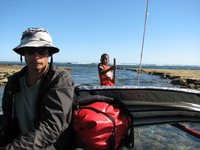
Soon we were off again, the southern wind befriending us for once, pushing us north towards Anakoa. Eventually we reached an area where the barrier reef opened up, allowing the surf to penetrate the inner lagoon. To our amazement there existed a passage through the inner reef allowing us to safely bypass the treacherous walls of white water.
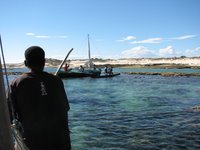
Again Marco demonstrated his ability as a waterman, navigating us through the narrow passage. Petit Marco was at the stern following his dad’s instructions to the T.


When we reached Anakoa we found the waves to be half the size as the southern waters, with a bunch of grumpy South Africans (paying upwards of $200 a day) bitching about the crowds and their bad luck. After looking at a nautical chart of the area, we realized the surf spots we had found were located off of a deepwater trench, which increased the wave size significantly. We kept that quiet and slipped out of town the next day, in a deep water cargo Laka heading back to Tulear.
To know that we left our newly discovered wave zone at the peak of the swell, forced to leave due to lack of hard cash, burned deep. But the realization of the adventure we had just experienced burned much brighter. We had learned and recorded a workable Vezo vocabulary. We had Xs on our nautical chart. We knew the culture, the winds, the tides, the reefs, and the spiny forest. We would return someday.
 This was my last photo taken on the return voyage to Tulear. The Vezo Paddle, the wooden single-outrigger Laka, and the cloth sail. Not a single piece of the synthetic modern world. Just ancient, proven technology, imported by their Malaysian ancestors hundreds of years ago.
This was my last photo taken on the return voyage to Tulear. The Vezo Paddle, the wooden single-outrigger Laka, and the cloth sail. Not a single piece of the synthetic modern world. Just ancient, proven technology, imported by their Malaysian ancestors hundreds of years ago.
4 Comments:
The smell of adventure and the pure and raw emotion of the unkown are truly addictive and inspirational things. Man you once said that I provided some inspiration for your journey well i want you to know now that the favour has been truly returned.
Mr. Berquist
keep the posts coming, their
really good, I had no idea you were
such a good story teller.
I almost feel like I'm there with you.
Well we finally got some snow but were still a long way out from some
epic runs, the wood only has about
14" base pretty sad but its still early. Rawly is good, 4 months old today 11\27
Just wanted to say hi and keep it up!!!
Late.......CAPONE
A glimpse into your reality is such a gift--a small token to cherish and hold onto until my next travels. Thank you for sharing--and keep the photos alive; they're stunning.
Hi Mr. Berquist,
You're so cool. I really want to travel. Good luck in Indonesia this year.
Eric Ngo,
4th Grade Student at Parkview School
Post a Comment
<< Home